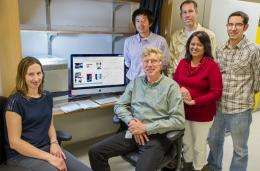Scientists developing quick way to ID people exposed to ionizing radiation

(Medical Xpress)—There's a reason emergency personnel train for the aftermath of a dirty bomb or an explosion at a nuclear power plant. They'll be faced with a deluge of urgent tasks, such as identifying who's been irradiated, who has an injury-induced infection, and who's suffering from both.
Unfortunately, there isn't a quick way to screen for people exposed to dangerous levels of radiation. There also isn't a quick way to distinguish between people suffering from radiation exposure versus an infection due to an injury or chemical exposure.
The most common way to measure exposure is a blood assay that tracks chromosomal changes. Another approach is to watch for the onset of physical symptoms. But these methods can take several days to provide results, which is far too late to identify people who'd benefit from immediate treatment.
A much faster way could be coming. Research conducted by scientists from the U.S. Department of Energy's Lawrence Berkeley National Laboratory (Berkeley Lab) could lead to a blood test that detects if a person has been exposed to radiation, measures their dose, and separates people suffering from inflammation injuries—all in a matter of hours.
The scientists identified eight DNA-repair genes in human blood whose expression responses change more than twofold soon after blood is exposed to radiation. They also learned how these genes respond when blood is exposed to inflammation stress, which can occur because of an injury or infection. Inflammation can mimic the effects of radiation and lead to false diagnoses.
The result is a panel of biochemical markers that can discriminate between blood samples exposed to radiation, inflammation, or both. The scientists believe these markers could be incorporated into a blood test that quickly triages people involved in radiation-related incidents.
They report their research in a paper recently published online in the journal PLOS ONE.
"In an emergency involving radiation exposure, it's likely that only a small fraction of all possibly exposed people will be exposed to high doses that require immediate medical attention," says Andy Wyrobek of Berkeley Lab's Life Sciences Division. "The goal is to quickly screen for these people so they can get treatment, and avoid overwhelming medical facilities with the larger number of people exposed to low levels of radiation with no immediate medical needs. Our research could lead to a blood test that enables this."
Wyrobek conducted the research with fellow Berkeley Lab scientists Helen Budworth and Antoine Snijders, as well as several other scientists from Berkeley Lab and other institutions.
Because DNA is one of the major targets of radiation, the Berkeley Lab scientists began their research by focusing on 40 genes that regulate the expression of proteins that carry out DNA-repair tasks. They studied these genes in blood samples taken from healthy people before and after exposing the samples to 2 Gray of X-rays per year, which is about the radiation dose received by radiotherapy patients. They found twelve genes that underwent more than a twofold change in response after exposure. From these, they isolated eight genes that had no overlap between unirradiated and irradiated samples.
The scientists also treated the blood samples with a compound that mimics inflammatory stress. This enabled them to account for gene-expression responses that could be mistaken for signs of radiation exposure, but which are actually caused by injury or infection. In addition, they irradiated a portion of these samples to learn how the genes respond to both inflammation and radiation.
To validate their findings, the scientists analyzed a separate dataset of blood samples that had also been irradiated. They found a close match between their own data and the independent dataset in how the eight genes respond after radiation exposure.
They also compared their findings to a large group of bone marrow transplant patients who received total-body radiation. Again, they found a close match between their data and the gene-expression responses of the patients after they received treatment.
More work is needed, but Wyrobek envisions a blood test using their biochemical markers could be administered via a handheld device similar to what diabetes patients use to check their blood sugar. The test could help emergency personnel quickly identify people exposed to high radiation doses who need immediate care, and people exposed to lower doses who only need long-term monitoring.
More information: www.plosone.org/article/info%3Adoi%2F10.1371%2Fjournal.pone.0048619
















